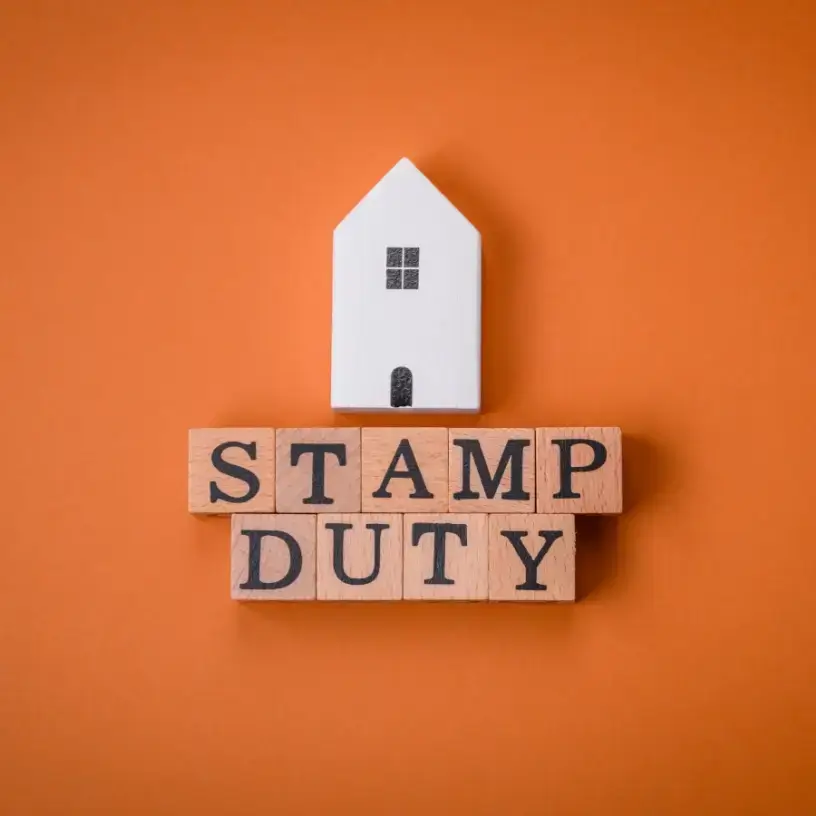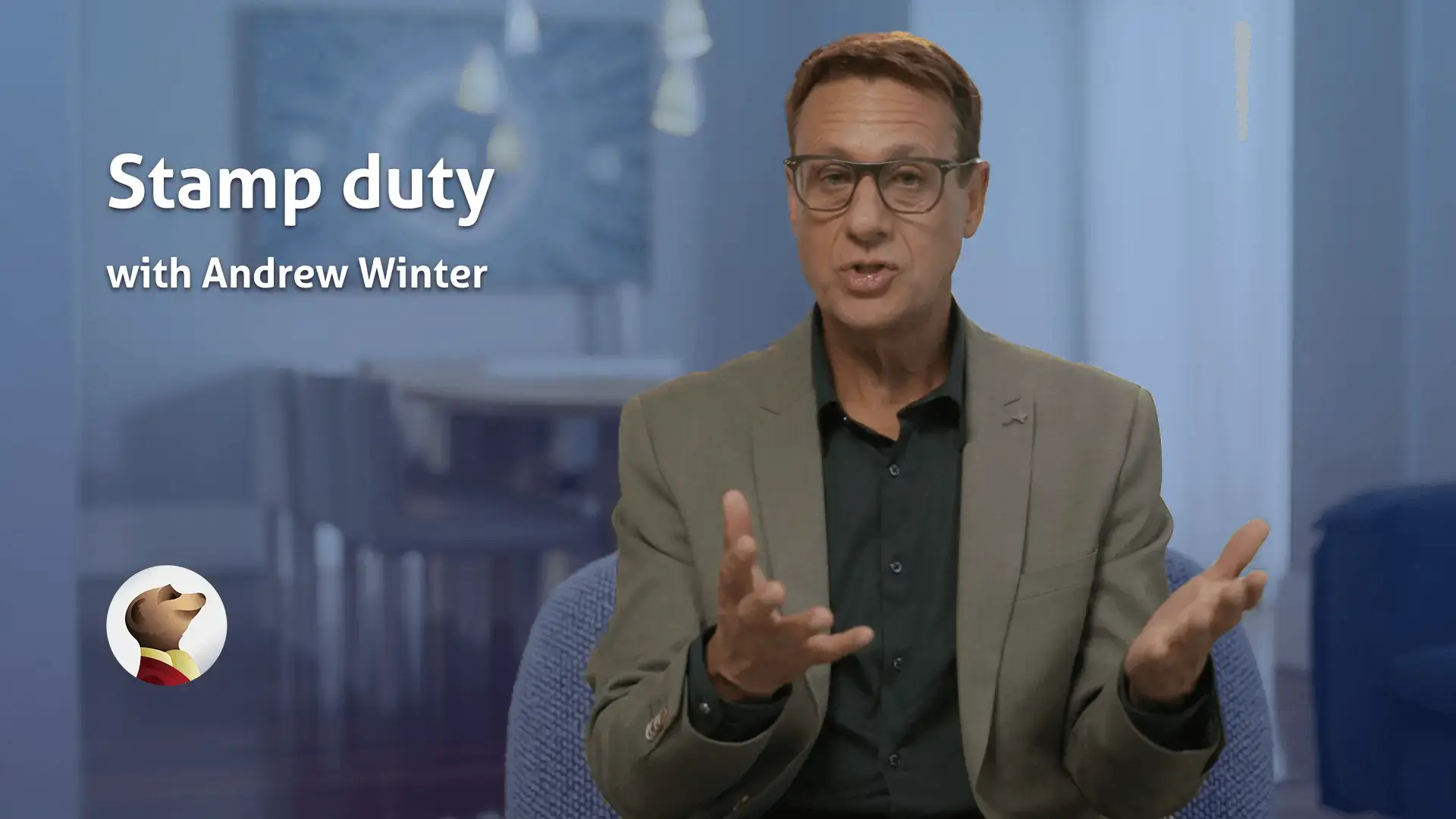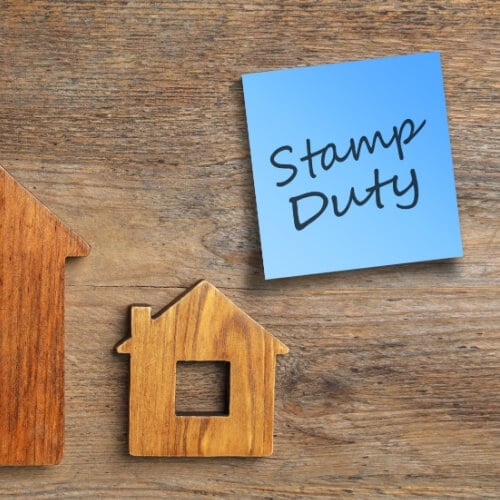Home / Home Loans / Stamp duty calculator Ta…

A guide to using our TAS stamp duty calculator
Updated 2 May 2024

Key takeaways
- Stamp duty (also known as transfer duty) is a government fee charged on property transactions
- It’s charged all around Australia, but each state and territory does it differently and charges different rates
- Depending on your buying circumstances you may be eligible for a concession that could reduce your payable stamp duty
- Stamp duty is typically an upfront cost, but in Tasmania it can be paid up to three months after the property is transferred into your name
Stamp duty and how it works



Hi, I’m Andrew Winter, host of Selling Houses Australia.
As someone who’s no stranger to the homebuying process, I’m well aware of what kinds of costs
I’ll have to deal with if I buy a property. But there are plenty of homebuying costs that
can catch first home buyers unawares, and the largest of these will typically be your transfer
duty – or ‘stamp duty’ as it’s often called. Stamp duty is a government tax that’s charged
whenever legal ownership of a property is transferred between two parties as part of a sale.
It’ll often cost the buyer – that’s you! – thousands, or even tens of thousands of dollars,
so it’s definitely a cost worth keeping in mind, and budgeting generously for.
Now, each state and territory charges different amounts of stamp duty on
different property value thresholds. So, you’ll need to make sure you’ve
looked at the specific rates and thresholds for where you live, to get an accurate idea
of what your stamp duty bill could look like. When it comes time to pay your stamp duty
which will usually be at settlement – you’ll typically be paying it completely out of pocket. Ouch.
The only exceptions I’d point out would be first home buyers, who are often eligible
for some sort of stamp duty discount or exemption. But even those aren’t guaranteed – you’ll need to
check what’s on offer in your state or territory, as well as with your conveyancer in order to
figure out the applicable government fees. Luckily, Compare the Market can help you
both understand how stamp duty is charged where you live, and then calculate your
payable stamp duty once you’re ready to buy. Their home loan comparison tool lets you specify
the property you’d like to buy, along with what you’re planning on using it for and your
particular buying circumstances, and then tells you how much stamp duty you’d pay on the purchase.
So, whether you’re a first home buyer or a seasoned property expert, Compare the Market
can help you with your next property journey – they make it as easy as comparing home loans.
Our TAS stamp duty calculator
Expert tips for stamp duty in Tasmania
Stamp duty can cost you tens of thousands of dollars, so it pays to be prepared. With that in mind, our General Manager of Money, Stephen Zeller has some stamp duty-related tips for Tasmanians:

Calculate right in the first instance
Stamp duty charges differ depending on where you’re purchasing a property in Australia. When working out the estimated stamp duty for a home you’re looking to purchase, make sure you’ve selected the correct state/territory as you could potentially underestimate or overestimate the charges applicable.
Include stamp duty in your homebuying costs
Stamp duty is often forgotten about when people are looking at homes for sale and calculating buying costs. When completing your sums for purchasing a home, don’t forget to include your stamp duty costs as well, or you might not have enough funds to complete the purchase.
We’re here to help!
Our Home Loan Specialist team is here to help with your stamp duty queries and any other home loan questions on your mind. Contact the team via phone or email and they’ll be happy to assist you.
How does stamp duty work in Tasmania?
How is stamp duty calculated in Tasmania?
When purchasing a property, there are a host of additional costs that are important to keep in mind – and stamp duty is perhaps the heftiest of them all. In Tasmania, stamp duty is charged on a sliding scale based on either the property’s market value, or the consideration (that is, the agreed purchase price of the property) – whichever figure is greater.¹
Tasmania’s payable stamp duty rates as of February 2024 are:
| Property value | Stamp duty payable |
|---|---|
| $3,000 or less | $50 |
| $3,000-$25,000 | $50, plus $1.75 for every $100 or part of $100 over $3,000 |
| $25,001-$75,000 | $435, plus $2.25 for every $100 or part of $100 over $25,000 |
| $75,001-$200,000 | $1,560, plus $3.50 for every $100 or part of $100 over $75,000 |
| $200,001-$375,000 | $5,935, plus $4.00 for every $100 or part of $100 over $200,000 |
| $375,001-$725,000 | $12,935, plus $4.25 for every $100 or part of $100 over $375,000 |
| More than $725,000 | $27,810, plus $4.50 for every $100 or part of $100 over $725,000 |
For example, imagine Sam buys a house in Tasmania for $500,000. Assuming Sam isn’t eligible for any stamp duty concessions or exemptions, they’re on the hook for $12,935 of stamp duty plus $4.25 for every $100 or part of $100 making up the difference between $375,000 and $500,000.
This difference is $125,000 which, when divided by $100, gives us 1,250. Multiply this by $4.25 and we get $5,312.50, and when added to $12,935, gives us a final amount of $18,247.50.
Keep in mind that this is a very basic estimation of the stamp duty Sam might have to pay on their property purchase. There are many different factors that can affect your payable stamp duty beyond the value of the property, so you may want to seek professional advice if you’re looking for a more accurate estimate.
Furthermore, the Tasmania state government offers several concessions and exemptions which, depending on your circumstances, may affect the amount of stamp duty you have to pay on your eligible property purchase.
What property types does stamp duty apply to in Tasmania?
Stamp duty is payable in Tasmania on the purchase and title transfer of:2
- Primary residences
- Holiday homes
- Investment properties
- Vacant land
- Commercial premises
- Farming properties
- Businesses including land or an interest land
- Acquisitions of any of the above by:
- Declaration of trust
- Gift
- Adding a name to a title
- Removing a name from a title
- Change of beneficial ownership.
When is stamp duty payable in Tasmania?
In Tasmania, you must pay stamp duty within three months of the property’s transferral into your name. However, most homebuyers will generally engage the services of a conveyancer or solicitor to assist them during the homebuying process, and they’ll typically handle the paying of your stamp duty for you.
You may want to check with your nominated conveyancer or solicitor for clarity on how this will work, and what the timeline looks like for the payment of your stamp duty.
Where do I pay stamp duty in Tasmania?
In Tasmania, you can pay your stamp duty via mail or electronically at Tasmania Revenue Online.2
However, most homebuyers tend to work with a solicitor or conveyancer during the homebuying process, and so they’ll typically handle the stamp duty payment process on your behalf.
Who has to pay stamp duty in Tasmania?
Do first home buyers pay stamp duty in Tasmania?
First home buyers in Tasmania who purchased an established home worth $600,000 or less and used it as their principal place of residence prior to 30 June 2024 may be eligible for a 50% concession on their payable stamp duty.3
Are there any other concessions or exemptions for stamp duty in Tasmania?
 Yes, Tasmania offers a number of stamp duty concessions and exemptions to eligible individuals, including:4
Yes, Tasmania offers a number of stamp duty concessions and exemptions to eligible individuals, including:4
- The previously mentioned 50% concession for eligible first home buyers.
- A 50% concession for eligible pensioners aged 60 years or older who’ve sold their existing property to downsize to a smaller home worth less than their former property, and less than $600,000 in total.
- A full stamp duty exemption for transfers in which a private dwelling is transferred between parties who are currently married, in a significant relationship or caring partners.
- A full exemption for situations in which a property is being transferred due to the breakdown of a marriage, de facto relationship or personal relationship.
- A full exemption for situations in which an interest in primary production land (and any associated farming equipment) is being transferred between relatives or to a trust or company involving a relative of the transferor.
However, each of these concessions and exemptions have their own stipulations and eligibility requirements. Be sure to thoroughly assess your own eligibility for any concessions or exemptions before you apply.
Are there any stamp duty concessions for pensioners in Tasmania?
As mentioned above, there’s a 50% stamp duty concession available to eligible pensioners downsizing to a smaller, less valuable property.5 To be eligible for this concession, the following conditions must be met:
- The purchase price of the property being bought must be less than the sale price of the property being sold, and worth $600,000 or less all up.
- The transfer of the new home was completed within six months of the selling date of the former home.
- The pensioner in question is:
- At least 60 years old
- Holds a Pensioner Concession Card, or receives a DVA special rate pension or holds a Commonwealth Seniors Health Card.
- The pensioner in question:
- Has used the former property as their principal place of residence for at least six months before the purchase of the new property
- Intends to be an owner-occupier of the new home and use it as their principal place of residence for at least six months
- Is the named owner of both properties
- Doesn’t own a home anywhere else in Australia at the time of the transfer other than their former principal place of residence
- Has not received this duty concession before.
Do foreign purchasers pay stamp duty in Tasmania?
Tasmania charges a Foreign Investor Duty Surcharger (FIDS) when residential or primary production property is acquired, directly or indirectly, by a foreign person.6
As of April 2020, the FIDS is charged at a rate of:
- 8% of the dutiable value of any residential property acquired by a foreign person, whether directly or indirectly.
- 1.5% of the dutiable value of any primary production property acquired by a foreign person, whether directly or indirectly.
Foreign buyers may be exempt from paying the FIDS if the property in question is an existing dwelling being purchased by parties to a marriage or significant relationship in equal shares, who plan on using it as their principal place of residence within six months of the purchase and only one of the parties is a foreign natural person.7
An exemption also exists for foreign buyers purchasing vacant land with the intention of building a principal place of residence on it. However, if you’re a foreign buyer considering buying property in Tasmania, you should investigate your own potential eligibility for a duty exemption before making any decisions.
Meet our home loans expert, Stephen Zeller
Stephen has more than 30 years of experience in the financial services industry and holds a Certificate IV in Finance and Mortgage Broking. He’s also a member of both the Australian and New Zealand Institute of Insurance and Finance (ANZIIF) and the Mortgage and Finance Association of Australia (MFAA).
Stephen leads our team of Mortgage Brokers, and reviews and contributes to Compare the Market’s banking-related content to ensure it’s as helpful and empowering as possible for our readers.
1 State Revenue Office of Tasmania. Rates of duty. 2024.
2 State Revenue Office of Tasmania. Property Transfer Duties. 2024.
3 State Revenue Office of Tasmania. First home buyers of established homes duty concession. 2024.
4 State Revenue Office of Tasmania. Concessions and exemptions. 2024.
5 State Revenue Office of Tasmania. Pensioners downsizing to a new home duty concession. 2024.
6 State Revenue Office of Tasmania. Rates of surcharge. 2024.
7 State Revenue Office of Tasmania. Exemptions. 2024.

